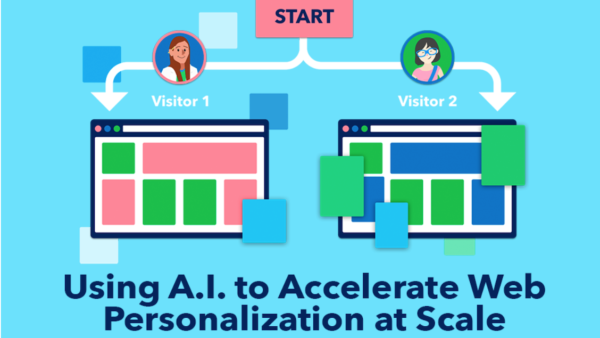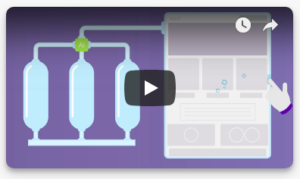Using A.I. to Accelerate Web Personalization at Scale

When was the last time you saw two snowflakes that were exactly alike? There is a pretty good chance that the answer to that question is never. Well, the exact same thing can be said for consumers.
No two are ever exactly alike either. That is why it is so baffling that the majority of companies think that they can get away with trying to generically engage all of their consumers in the same way.
Most often, the only thing that this approach will get them is an increase in the amount of disengaged and unsubscribed consumers.
Seeing as this is the exact opposite of what any marketing or e-commerce site is looking for, it seems fairly obvious that if a company is currently using this approach, then they are in desperate need of a change. However, the question remains – what’s the alternative? Luckily, the answer to this is quite simple.
If a business wants to improve their consumer engagement, conversion rates, and profitability by up to 38%, then they need to start engaging with an AI-based web personalization strategy.
What Are the Benefits of Web Personalization?
As previously mentioned, treating two very different things the same is not going to get companies anywhere. Therefore, the answer to their conversion issues lies in web personalization. But how exactly does personalizing the approach of a website helps increase conversion rates? The short answer to this is through multiple ways. To get the long answer, keep reading.
Before we can get to the exciting benefits that what personalization can offer, we first need to establish what web personalization entails.
Obviously, personalizing the entire website for each individual person is unreasonable at this stage of technology, but anything is possible for the future. Therefore, companies must instead personalize the KEY portions of their websites for each visitor.
Using Heatmaps to Personalize
A great way to identify personalization opportunities is to implement heatmaps, which allow companies to see exactly where their visitors are spending the most time on their website.
If the vast majority of them never happen to read past the third paragraph of a certain page, then this is something that companies need to know. This shows that whatever information is located in those first three paragraphs are what the consumers care about, so that should be where they focus their personalization efforts.
The Benefits of Geolocation
One of the most popular ways to integrate web personalization into a company’s site is through the use of geolocation.
These are able to determine exactly where a user is accessing the website from so that relevant deals can be offered to that individual. This helps to avoid embarrassing situations like trying to offer a deal on a winter coat to someone who lives in Hawaii.
Common examples of geolocation being used to improve a site’s performance include:
- Displaying events occurring near the individual’s location,
- Inviting visitors to go to the store location that is closest to them, and
- Presenting location-based promotions.
Personalize for Conversions
One of the most commonly customized elements of a website are the call to actions (CTA). These often take the form of a button and/or a link. Regardless of how they appear, they can still be personalized to increase conversions.
Some companies are doing relatively well with their CTAs, such as eCommerce sites with an 8.16% conversion rate, while others are doing quite poorly, such as marketing sites with a 2.47% conversion rate. A poor conversion rate is generally due to using a standard CTA message that is the exact same for every visitor, regardless of how they interact with the site.
Another option, which is significantly more effective than just using a standard CTA, is to take the time to personalize CTAs. This means that the message used in the CTA will vary depending on the specifics of the visitor and their relationship with the website. If it is someone who regularly visits the site or happens to have spent a significant portion of time on the site, then the CTA will feature language that is more direct. This may include something along the lines of “Checkout Now” or “Speak with a sales rep”.
On the other hand, a personalized CTA will also be able to tell when someone is new to the site or is not acting very interested. In this case, it could display a much more passive message, such as “View a Demo” or “See today’s specials”.
By personalizing CTA messages, it has been shown to increase conversion rates by 202%. One of the main reasons for this is simply because personalized messages stand out a whole lot more than generic messages. When the CTA is able to nudge them just the right amount, and even make recommendations specifically related to the pages they have looked at, then it is much more likely to get them to engage with the site and become an official customer.
Benefits of Web Personalization at Scale
In order to take full advantage of web personalization tactics, companies need to make sure that they are doing it at scale. Otherwise, their “personalized approach” is being used on too broad of a segment, resulting in very little impact.
By narrowing the number of people that each approach targets, it vastly increases the odds that the contents in the message will strike a chord with them.
For example, sending an offer for cheap hotel deals in a European city to everyone who has created an account on the company site in the last two weeks is only going to be enticing for a small portion of them.
However, by sending this exact same message to anyone who has looked at other products or services in Europe in the last two weeks, this personalized approach is suddenly matched with a very relevant segment and will be significantly more successful.
How AI Accelerates Web Personalization
The fact is that trying to develop a personalized approach for every customer is something that takes a lot of time, and is almost always beyond the capabilities of any single person. Even with a smaller customer base, trying to track the habits of each of their visits and then develop personalized methods of communicating with them based on these factors, is something that would take over an hour for each person. That is where using AI can really come in handy.
Artificial intelligence systems are able to process a visitor’s intent and demographic data in a matter of seconds. They are able to respond to it in a personalized way just as fast, creating a real-time response to each and every consumer.
This is why almost half of all marketing professionals have already embraced the use of AI for customer data analysis.
Whereas human employees might think to only look at what a consumer clicks on or how far they get down a page before exiting, AI looks at so much more by also including how much time someone spends reading a certain section and how many times they visit a specific page within a certain period of time. These are all things that can be used to significantly improve the personalized approach that it is able to offer.
AI systems are also able to track consumers across a variety of devices, so if someone starts looking at a site on their laptop and then switches over to their phone halfway through, this is something that AI would be able to pick up on and track.
In order to gain unlimited access to AI systems that are able to provide personalized notifications, guidance, and recommended new actions, all based on a visitor’s digital body language, contact the Reactful team today.






